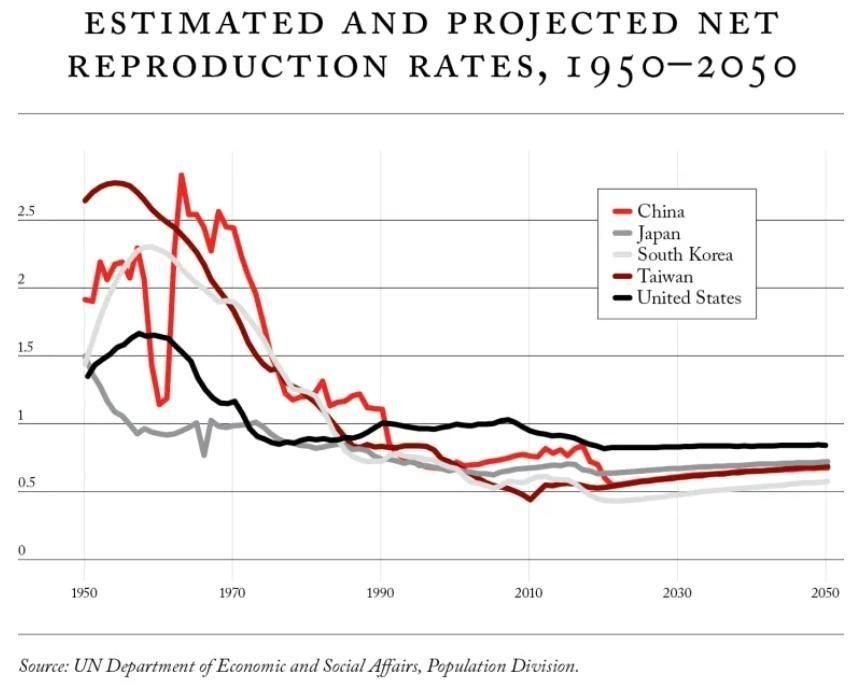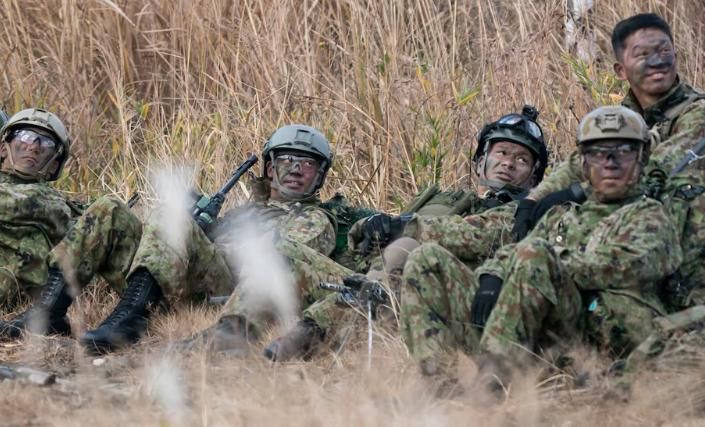By Eric Vandenbroeck and co-workers
The Japanese Military Has a People
Problem
We pointed out the
population decline in Japan twice during the past years (here and here).
Whereby mor recently in 2024, the number of babies born in Japan fell to a
record low for the ninth year in a row. With about 1.6 million deaths and
720,988 births, there were about two deaths for every new baby born. Japanese
governments have proposed policies to reverse this trend, but they
have so far had little success. Thirty percent of the country’s population is
over the age of 65, and by 2070, this number is projected to be 40 percent. The
shrinking and aging of Japan’s population will transform Japanese society. But
it will have a particular effect on a major concern of the government: national
defense.
The Japanese
government passed a record defense budget in 2024, in line with its commitment
to increase its defense spending to two percent of its GDP by 2027.
The country’s new prime minister, Shigeru Ishiba, has
long sought to bolster Japan’s independent security capabilities and become a
more equal partner in its military alliance with the United States, which has
for decades pressured Japan to step up. Even before President Donald Trump’s
re-election, Japan had begun to make bolder military pledges. Under former
Prime Minister Fumio Kishida, who led the country from 2021 to 2024, Japan
outlined plans to double its defense spending by 2027, loosen restrictions on
weapons development, and strengthen relations with like-minded countries around
the world.
The battering of the
Liberal Democratic Party in recent national elections has cast doubt on whether
these increased investments in defense will be possible. Although the LDP
remains the largest party in the National Diet, with Ishiba
as its leader, the party lost 56 seats in October 2024, failing to reach a
majority. Trump’s determination to put pressure on U.S. allies to pay their
“fair share” in maintaining security partnerships has only heightened the
stakes.
But even if Ishiba manages to garner the necessary political support
for more defense spending, Japan will have to face the dire demographic
headwinds. The decline of its population will almost certainly ensure that it
will fall short of the grand aspirations of Japanese policymakers and their
U.S. counterparts. Japan’s population is so old, and shrinking so quickly, that
it may not be able to field and fund an adequate defense force to meet growing
alliance demands in an increasingly volatile world. The size of its forces are
already vastly outmatched by its primary adversaries; Japan’s military is
one-tenth the size of China’s active forces and one-fifth of North Korea’s.

If present population
trends continue, they could severely limit recruitment for the already
chronically understaffed Japan Self-Defense Force, restrain the state’s ability
to tax the population to fund increased defense expenditures, and stifle the
innovation needed to compete in the defense sector. Without more people, Japan
will struggle not only to address its current security threats but also to play
the larger role in global affairs that Japanese and U.S. officials want it to. The
solution is at once simple and improbable. People need to have more
children, but few leaders are willing to say this out loud or to address the
obstacles that younger generations face in balancing their careers with their
family lives.
Strength in Numbers
Japan is not the only
country suffering from these trends. Several U.S. allies and
partners have even lower fertility rates than Japan, facing declines that could
soon affect defense preparedness. Ukraine, which had a low birthrate even
before Russia’s full-scale invasion in 2022, now has one below one child per
woman, according to the UN Population Fund. Taiwan has a fertility rate of
around 0.87. (Demographers generally set the “replacement level,” at which a
country’s population remains stable, at 2.1 children per woman.) In South
Korea, academics and former military professionals have warned that a shrinking
population may force an eventual downsizing of its armed forces. And
policymakers in the United States will also have to face the reality that the
country’s falling birthrates and declining pool of eligible recruits could
eventually weaken U.S. forces if such trends continue.
The Japanese military
is particularly vulnerable to the consequences of demographic change. Since its
founding in 1954, the force has rarely met its recruitment targets, and decades
of economic stagnation, stigmas around military service, and recent sexual
harassment scandals have discouraged many young Japanese from enlisting.
Further, part of the reason Japan needs more troops is that the world is
becoming a more dangerous place, and many young people don’t want to put
themselves on the frontline. The Ministry of Defense has sought to appeal to
younger generations—by using celebrities, messages about peace, and anime in
its advertising, for example—and has raised the maximum age of recruits from 26
to 32. But these efforts have had little effect: in 2023, the ministry missed
its recruitment goal by more than 50 percent. That failure is not helped by
Japan’s ever-dwindling pool of possible recruits. In fact, over the last three
decades, the number of Japanese 18- to 26-year-olds, the primary recruiting population,
has declined by around 40 percent, from 17.43 million in 1994 to 10.2 million
in 2024. To meet its recruitment quotas for the coming decade, Japan would need
to eventually enlist more than one percent of its entire population—a herculean
task.
The effects of
dwindling numbers are already being felt across the ranks. In 2018, Noboru
Yamaguchi, a retired lieutenant general in Japan’s army, told me that the
warped ratio between senior and junior noncommissioned officers,
with many senior officers having only a few junior officers to supervise, has
hindered leadership development in the forces, leading to low morale and the
belief among senior officers that their job is unimportant and unfulfilling.
The inability to fill the military ranks will also eventually require painful
decisions over where to deploy the limited troops and what additional alliance
duties Japan can take on.
This challenge is
particularly alarming given the massive disparities between the present size of
the militaries of Japan and its closest allies compared with those of its
primary adversaries. In 2022, the number of Japanese military personnel stood
at a measly 227,843, while the United States had approximately 1.3 million
active forces and South Korea about 500,000 (Seoul has around a further 3
million reserve forces). China’s military, on the other hand, features
approximately 2 million active personnel, and North Korea’s about 1.2 million.
Indeed, when it comes to a possible conflict between Japan and China and North
Korea, retired Vice Admiral Yoji Koda told Reuters in 2022 that “manpower is
the real issue.”

Less Isn’t More
The effect of an
aging society on defense goes beyond recruitment. It also constrains the
national budget and stymies innovation. Japan’s new defense strategy, unveiled
in 2022, will require an estimated $300 billion through 2027. But
entitlement demands continue to dominate spending as the single largest
government expenditure, with over 37.7 trillion yen ($222 billion), or 33.5
percent of the national budget, allocated for social security in 2024—three
times the level in 1990. These demands will only grow as the population
continues to age and the workforce continues to shrink, with increasing
reliance on national health care and pension systems and a contracting tax pool
to fund them. The last three decades of economic stagnation—the stock market
only returned to its 1990 high in 2024—has further impeded efforts to raise
revenue, and efforts by Kishida to raise taxes for defense during his term
floundered.
Japan’s shrinking
population is complicating the country’s efforts to develop a larger indigenous
defense sector and decrease its reliance on U.S. weapons and munitions—a
crucial pillar of its defense overhaul. In 2023, Japan ranked 32nd on the
International Institute for Management Development’s World Digital
Competitiveness Ranking—its worst placement since the list began in 2017. The
country is facing engineer shortages in the vital chip industry, a shrinking
college-age population, and a falling number of doctoral degree recipients,
further weakening Japan’s prospects for economic productivity. This all means
less brain power for research and development and less physical labor for
assembly lines and transportation.
Japan’s Ministry of
Defense has been forthright in acknowledging that the demographic crisis will
affect national security. It outlined, in its new security strategy in 2022,
how the rapid population decline would require a more efficient use of its budget
and labor force. The Japanese military has tried to adapt its operations to a
smaller force, including by retrofitting vehicles and ships to operate with
fewer people and relying on advanced technology to carry out tasks
traditionally assigned to people. In December 2024, the Ishiba
government approved funding within its 2025 fiscal budget to increase wages and
implement new measures to improve work-life balance in the armed forces.
Yet even with a more
efficient and technologically enabled force, Japan’s military will still
require manpower. Applying a strategy of so-called minimal manning—working with
as few service members as possible—is not a solution but a Band-Aid. To
develop, produce, and operate new and increasingly indispensable technologies,
Japan will need more highly trained—and highly paid—soldiers for advanced
warfare. And infrastructure such as ships require several hundred people to
operate.
Fewer people will
therefore mean that troops have to endure longer deployments, commanders will
have less flexibility in deploying troops, casualties will exact a greater toll
on the capacities of the military, and the military will face greater constraints
in staffing new battalions and engaging in operations. All of this will put
further stress on current service members, making military jobs even less
desirable. This means that Japan cannot dedicate the resources needed to
become a stronger, more equal partner in its alliance with the United States,
never mind taking on a larger role in the Indo-Pacific.

Managing Expectations
Most of the Japanese
government’s proposals to address the country’s demographic challenges have
thus far not gained traction. In recent years, Japanese leaders have pursued
policies to encourage families to have more children. In 2023, for example,
Kishida introduced a plan to double government spending on childcare support by
2030, but the new childcare law passed in 2024 under Ishiba
amounts to less than half the amount Kishida outlined. Kishida’s other scheme,
to pay for college tuition for families with three or more children, was widely
criticized on Japanese social media as unserious and impractical and helped
sink his approval rating; although the measure passed, its effect will be
almost impossible to measure for at least two decades.
Another solution that
scholars and pundits often propose is to encourage more immigration; Japan has
historically not welcomed many immigrants, and some analysts imagine that a
significant reset of this policy will bring needed dynamism and vitality to the
economy and Japanese society. But immigration is not a permanent fix. Newcomers
could eventually replicate Japanese birthrates. They would also bring in new
costs, namely when it comes to social integration, and the government would
also eventually have to pay for further entitlements if immigrants settle and
age in Japan. And in terms of recruitment to the country’s military, only
Japanese citizens can join Japan’s armed forces.
In my discussions
with politicians, bureaucrats, and demographers in Japan last summer, many
feared that the solution to the demographic crisis is far too crass to say out
loud. Japan needs more consumers, soldiers, and taxpayers, and so families need
to have more children. But few ministries have implemented policies that will
address the stubborn gender norms that make it extremely difficult for women to
have children, maintain their careers, and enjoy a healthy work-life balance.
Invoking national security needs will do little to spur couples into action.
“If you want babies, you can do it and the government will support it,” one
Japanese official told me. “But to argue that we have to increase the birthrate
because of our national security, it is a very difficult thing to put in the
right context.”
The United States
can pester Japan all it wants about dedicating more resources to defense, but
Japan is not likely to fulfill either country’s dream of a stronger, more equal
U.S.-Japanese alliance. If it were up to Ishiba,
Japan would already be on its way to reaching that goal. But there are few
guarantees that Ishiba will be able to follow through
on the agenda set by his predecessor, especially after his party lost its
legislative majority in October. Doubling Japan’s defense spending now will
strengthen the country’s national security, but such increases are unlikely to
stretch into the long term, Japanese troops are not likely to be able to deploy
in large numbers abroad, and the Japanese government will not eagerly turn to
military force over diplomacy. Both Tokyo and Washington must adjust their
expectations for what Japan—and other partners facing similar demographic
declines—can reasonably achieve, especially in the long term, when the
consequences of an aging and shrinking population will be even more severe.
For updates click hompage here